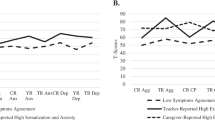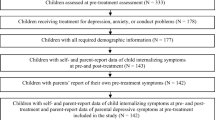Abstract
In the field of child and adolescent psychopathology, discrepancy among informants (e.g., mother and child) is common. Discrepancies are an important topic of research as assessments utilize multiple informants, which guild clinicians’ diagnostic, treatment, and research decisions. The difference score between mothers and youth report of internalizing disorders, broadly, has been found to be associated with youth’s negative self-esteem. However, the relationship among these variables has only been examined through the use of difference scores, which have significant limitations. The current study aimed to examine whether the discrepancy between maternal- and self-reported withdrawn and anxious/depressed symptoms (respectively) would be predictive of youths’ self-reported negative self-esteem. We extend the literature by utilizing polynomial regressions to examine the linear and curvilinear main effects and interactions between mother and youth report. One-hundred and fifty-one child-mother dyads (age range, 11–17 years; Mage = 12.98 ± 2.42 years; 82 males and 69 females) were administered the Child-Behavior Checklist, Child Depression Inventory, and Youth Self-Report scale. Our results supported our hypotheses; when mothers and youth disagreed on the respective internalizing symptoms, youth were more likely to report lower self-esteem (higher negative self-esteem). The implications and limitations of the current study are discussed.


Similar content being viewed by others
References
Abela, J. R., & Skitch, S. A. (2007). Dysfunctional attitudes, self-esteem, and hassles: Cognitive vulnerability to depression in children of affectively ill parents. Behaviour Research and Therapy, 45(6), 1127–1140.
Achenbach, T. M., & Rescorla, L. A. (2001). Manual for the ASEBA School-age Forms & Profiles. Burlington: University of Vermont, Research Center for Children, Youth, & Families.
Achenbach, T. M., McConaughy, S. H., & Howell, C. T. (1987). Child/adolescent behavioral and emotional problems: Implications of cross-informant correlations for situational specificity. Psychological Bulletin, 101(2), 213–232.
Amato, P. R. (1986). Marital conflict, the parent-child relationship and child self-esteem. Family Relations, 403–410.
American Psychiatric Association. (2000). Diagnostic and statistical manual of mental disorders, (4th ed., text revision). Washington, DC: American Psychiatric Association.
Battle, J. (1987). Relationship between self-esteem and depression among children. Psychological Reports, 60, 1187–1190.
Becker-Haimes, E. M., Jensen-Doss, A., Birmaher, B., Kendall, P. C., & Ginsburg, G. S. (2018). Parent–youth informant disagreement: Implications for youth anxiety treatment. Clinical Child Psychology and Psychiatry, 23(1), 42–56.
Berg-Nielsen, T. S., Vika, A., & Dahl, A. A. (2003). When adolescents disagree with their mothers: CBCL-YSR discrepancies related to maternal depression and adolescent self-esteem. Child: Care, Health and Development, 29(3), 207–213.
Brookman-Frazee, L., Haine, R. A., Gabayan, E. N., & Garland, A. F. (2008). Predicting frequency of treatment visits in community-based youth psychotherapy. Psychological Services, 5, 126–138.
Bun, J. R., Louiselle, P. A., Misukanis, T. M., & Mueller, R. A. (1988). Effects of parental authoritarianism and authoritativeness on self-esteem. Personality and Social Psychology Bulletin, 14(27), 1–282.
Buri, J. R. (1989). Self-esteem and appraisals of parental behavior. Journal of Adolescent Research, 4(1), 33–49.
Cohen, J., Cohen, P., West, S. G., & Aiken, L. S. (2003). Applied multiple regression/correlation analysis for the behavioral sciences (3rd ed.). Mahwah: Lawrence Erlbaum Associates Publishers.
De Los Reyes, A. (2011). Introduction to the special section. More than measurement error: Discovering meaning behind informant discrepancies in clinical assessments of children and adolescents. Journal of Clinical Child and Adolescent Psychology, 40, 1–9.
De Los Reyes, A. (2013). Strategic objectives for improving understanding of informant discrepancies in developmental psychopathology research. Development and Psychopathology, 25, 669–682.
De Los Reyes, A., & Kazdin, A. E. (2005). Informant discrepancies in the assessment of childhood psychopathology: A critical review, theoretical framework, and recommendations for further study. Psychological Bulletin, 131, 483–509.
De Los Reyes, A., & Ohannessian, C. M. (2016). Introduction to the special issue: Discrepancies in adolescent-parent perceptions of the family and adolescent adjustment. Journal of Youth and Adolescent, 45, 1957–1972.
De Los Reyes, A., Kundey, S. M., & Wang, M. (2011). The end of the primary outcome measure: A research agenda for constructing its replacement. Clinical Psychology Review, 31(5), 829–838.
De Los Reyes, A., Thomas, S. A., Goodman, K. L., & Kundey, S. M. A. (2013). Principles underlying the use of multiple informants’ reports. Annual Review of Clinical Psychology, 9, 123–149.
De Los Reyes, A., Augenstein, T. M., Wang, M., Thomas, S. A., Drabick, D. A. G., Burger, D. E., & Rabinowitz, J. (2015). The validity of the multi-informant approach to assessing child and adolescent mental health. Psychological Bulletin, 141(4), 858–900.
De Los Reyes, A., Ohannessian, C. M., & Laird, R. D. (2016). Developmental changes in discrepancies between adolescents’ and their mothers’ views of family communication. Journal of Child and Family Studies, 25, 790–797.
Ebesutani, C., Bernstein, A., Martinez, J. I., Chorpita, B. F., & Weisz, J. R. (2011). The youth self report: Applicability and validity across younger and older youths. Journal of Clinical Child & Adolescent Psychology, 40(2), 338–346.
Edwards, J. R. (1994). The study of congruence in organizational behavior research: Critique and a proposed alternative. Organizational Behavior and Human Decision Processes, 58, 51–100.
Ferdinand, R. F., van der Ende, J., & Verhulst, F. C. (2004). Parent-adolescent disagreement regarding psychopathology in adolescents from the general population as a risk factor for adverse outcome. Journal of Abnormal Psychology, 113, 198–206.
Ferdinand, R. F., van der Ende, J., & Verhulst, F. C. (2006). Prognostic value of parent–adolescent disagreement in a referred sample. European Child & Adolescent Psychiatry, 15, 156–162.
Goodman, S. H., Adamson, L. B., Riniti, J., & Cole, S. (1994). Mothers' expressed attitudes: Associations with maternal depression and children's self-esteem and psychopathology. Journal of the American Academy of Child & Adolescent Psychiatry, 33(9), 1265–1274.
Guion, K., Mrug, S., & Windle, M. (2009). Predictive value of informant discrepancies in reports of parenting: Relations to early adolescents’ adjustment. Journal of Abnormal Child Psychology, 37, 17–30.
Harter, S. (1987) The determinants and mediational role of global self-worth in children. In: Contemporary Topics in Developmental Psychology (ed. N. Eisenberg). Wiley, New York.
Hawley, K. M., & Weisz, J. R. (2003). Child, parent and therapist (dis)agreement on target problems in outpatient therapy: The therapist’s dilemma and its implications. Journal of Consulting and Clinical Psychology, 71(1), 62–70.
Hopkins, H. R., & Klein, H. A. (1993). Multidimensional self-perception: Linkages to parental nurturance. The Journal of Genetic Psychology, 154, 465–474.
Israel, P., Thomsen, P. H., Langeveld, J. H., & Stormark, K. M. (2007). Parent–youth discrepancy in the assessment and treatment of youth in usual clinical care setting: Consequences to parent involvement. European Child & Adolescent Psychiatry, 16(2), 138–148.
Kazdin, A. E. (1989). Developmental psychopathology: Current research, issues, and directions. American Psychologist, 44(2), 180–187.
Klein, H. A., O'Bryant, K., & Hopkins, H. R. (1996). Recalled parental authority style and self-perception in college men and women. The Journal of Genetic Psychology, 157, 5–17.
Kolko, D. J., & Kazdin, A. E. (1993). Emotional/behavioral problems in clinic and nonclinic children: Correspondence among child, parent and teacher reports. The Journal of Child Psychology and Psychiatry, and Allied Disciplines, 34, 991–100.
Kovacs, M. (1992). Children’s depression inventory (CDI). Toronto: Multi-Health Systems Inc..
Laible, D. J., Carlo, G., & Roesch, S. C. (2004). Pathways to self-esteem in late adolescence: The role of parent and peer attachment, empathy, and social behaviours. Journal of Adolescence, 27(6), 703–716.
Laird, R. D., & De Los Reyes, A. (2012). Testing informant discrepancies as predictors of early adolescent psychopathology: Why difference scores cannot tell you what you want to know and how polynomial regression may. Journal of Abnormal Child Psychology, 41, 1–14.
Laird, R. D., & De Los Reyes, A. (2013). Testing informant discrepancies as predictors of early adolescent psychopathology: Why difference scores cannot tell you what you want to know and how polynomial regression may. Journal of Abnormal Child Psychology, 41, 1–14.
Laird, R. D., & LaFleur, L. K. (2016). Disclosure and monitoring as predictors of mother adolescent agreement in reports of early adolescent rule-breaking behavior. Journal of Clinical Child and Adolescent Psychology, 45, 188–200.
Moksnes, U. K., Moljord, I. E., Espnes, G. A., & Byrne, D. G. (2010). The association between stress and emotional states in adolescents: The role of gender and self-esteem. Personality and Individual Differences, 49(5), 430–435.
Muris, P., Meesters, C., & Fijen, P. (2003). The self-perception profile for children: Further evidence for its factor structure, reliability, and validity. Personality and Individual Differences, 35(8), 1791–1802.
Parish, T. S., & McCluskey, J. J. (1992). The relationship between parenting styles and young adults' self-concepts and evaluations of parents. Adolescence, 27(108), 915–918.
Post, P. (1999). Impact of child-centered play therapy on the self-esteem, locus of control, and anxiety of at-risk 4th, 5th, and 6th grade students. International Journal of Play Therapy, 8(2), 1–18.
Renouf, A. G., & Harter, S. (1990). Self-worth and anger as components of the depressive experience in young adolescents. Development and Psychopathology, 2, 293–310.
Richters, J. E. (1992). Depressed mothers as informants about their children: A critical review of the evidence for distortion. Psychological Bulletin, 112, 485–499.
Roberts, R. E., & Bengtson, V. L. (1993). Relationships with parents, self-esteem, and psychological well-being in young adulthood. Social Psychology Quarterly, 263–277.
Saylor, C. F., Finch, A. J., Spirito, A., & Bennett, B. (1984). The Children’s depression inventory: A systematic evaluation of psychometric properties. Journal of Consulting & Clinical Psychology, 52(6), 955–967.
Tabachnick, B. G., & Fidell, L. S. (2007). Using multivariate statistics (5th ed.). Boston: Allyn & Bacon/Pearson Education.
Treutler, C. M., & Epkins, C. C. (2003). Are discrepancies among child, mother, and father reports on children's behavior related to parents' psychological symptoms and aspects of parent–child relationships? Journal of Abnormal Child Psychology, 31(1), 13–27.
Trzesniewski, K. H., Donnellan, M. B., Moffitt, T. E., Robins, R. W., Poulton, R., & Caspi, A. (2006). Low self-esteem during adolescence predicts poor health, criminal behavior, and limited economic prospects during adulthood. Developmental Psychology, 42(2), 381–390.
Van Roy, B., Groholt, B., Heyerdahl, S., & Clench-Aas, J. (2010). Understanding discrepancies in parent-child reporting of emotional and behavioural problems: Effects of relational and socio-demographic factors. BMC Psychiatry, 10(1), 56.
Wilkinson, R. B. (2004). The role of parental and peer attachment in the psychological health and self-esteem of adolescents. Journal of youth and adolescence, 33(6), 479–493.
Yeh, M., & Weisz, J. R. (2001). Why are we here at the clinic? Parent-child (dis)agreement on referral problems at outpatient treatment entry. Journal of Consulting and Clinical Psychology, 69, 1018–1025.
Author information
Authors and Affiliations
Corresponding author
Ethics declarations
Ethical Approval
All procedures performed in studies involving human participants were in accordance with the ethical standards of the institutional and/or national research committee and with the 1964 Helsinki declaration and its later amendments or comparable ethical standards.
Informed Consent
Informed consent was obtained from all individual participants included in the study.
Conflict of Interest
On behalf of all authors, the corresponding author states that there is no conflict of interest.
Additional information
Publisher’s Note
Springer Nature remains neutral with regard to jurisdictional claims in published maps and institutional affiliations.
Rights and permissions
About this article
Cite this article
Castagna, P.J., Calamia, M. & Davis, T.E. The Discrepancy between Mother and Youth Reported Internalizing Symptoms Predicts Youth’s Negative Self-Esteem. Curr Psychol 40, 5312–5321 (2021). https://doi.org/10.1007/s12144-019-00501-9
Published:
Issue Date:
DOI: https://doi.org/10.1007/s12144-019-00501-9




